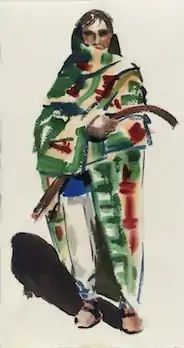José Vicente Aguilar | |
|---|---|
Sua Peen | |
| Born | January 8, 1924 |
| Nationality | American; San Ildefonso and Picurís Pueblo |

José Vicente Aguilar (born January 8, 1924), also called Sua Peen (Warm Mountain), is a Pueblo-American painter of San Ildefonso Pueblo and Picurís Pueblo heritage.[1] He is known for his watercolor paintings. Aguilar has exhibited across the United States, particularly in the Southwest,[2] and his work is in the permanent collection of institutions including the Gilcrease Museum.[3]
Early life
Aguilar was born in San Ildefonso, New Mexico, to José Angela Aguilar (San Ildefonso tribe) and Rosalie Simbola (Picurís tribe).[1] Both of his parents were artists known for their black-on-black pottery, and a number of his siblings also became active in the arts, including his younger brother Alfred Aguilar.[4]
As a child, Aguilar attended a number of schools across the country, including the San Ildefonso Pueblo Day School in New Mexico and the Montezuma Boys' School in Los Altos, California. From 1935 to 1940, he was a student at the Santa Fe Indian School, where he studied under Dorothy Dunn.[1][5] He then attended Monson High School in Monson, Massachusetts, followed by Hollywood High School in Hollywood, California.[1]
Career
Aguilar spent two years in the United States Army during World War II, serving in the European theater. For his service, he received the Purple Heart.[6]
When he returned, he continued his studies at Otis Art Institute (Los Angeles), the University of New Mexico, Hill and Canyon School of Art, and the Los Angeles Trade Technical Junior College, ending 1951.[1]
Aguilar then worked as a technical artist for the aircraft industry, including at Lockheed Aircraft Corporation, Douglas Aircraft Co., and North American Aviation.[1] During this time, he continued creating fine art and furthering his art education, getting additional schooling at the Los Angeles County Art Institute and the Los Angeles Art Center School.[1]
Artistic style
Aguilar's early paintings follow the traditional Pueblo style of painting often seen by those educated at the Santa Fe Indian School.[7][8] As his style matured, he was influenced by artists like Joe Herrera, and Aguilar began to utilize semi-abstract backgrounds and more loosely rendered figures.[2]
References
- 1 2 3 4 5 6 7 King, Jeanne Snodgrass (1968). American Indian painters; a biographical directory. Smithsonian Libraries. New York : Museum of the American Indian, Heye Foundation.
- 1 2 Tanner, Clara Lee (1973). Southwest Indian Painting. Tucson: The University of Arizona Press. pp. 129–131. ISBN 978-0-8165-0309-4.
- ↑ "Ball Player / Jose Vincente Aguilar, 1924- (Artist) - Gilcrease Museum". collections.gilcrease.org. Retrieved 2021-02-14.
- ↑ Schaaf, Gregory (2000). Pueblo Indian Pottery: 750 Artist Biographies, C. 1800-present : with Value/price Guide Featuring Over 20 Years of Auction Records. CIAC Press. ISBN 978-0-9666948-1-9.
- ↑ Wade, Edwin L., ed. (1986). The arts of the North American Indian : native traditions in evolution. New York : Hudson Hills Press in association with Philbrook Art Center, Tulsa. ISBN 978-0-933920-55-2.
- ↑ Dictionary of Indians of North America. St. Clair Shores, Mich. : Scholar[l]y Press. 1978. pp. 19–20. ISBN 978-0-403-01799-7.
- ↑ Brody, J. J. (1971). Indian painters & white patrons. Internet Archive. Albuquerque, University of New Mexico Press. ISBN 978-0-8263-0192-5.
- ↑ Warner, John Anson (1975). The life & art of the North American Indian. Internet Archive. New York : Crescent Books. ISBN 978-0-517-13127-5.